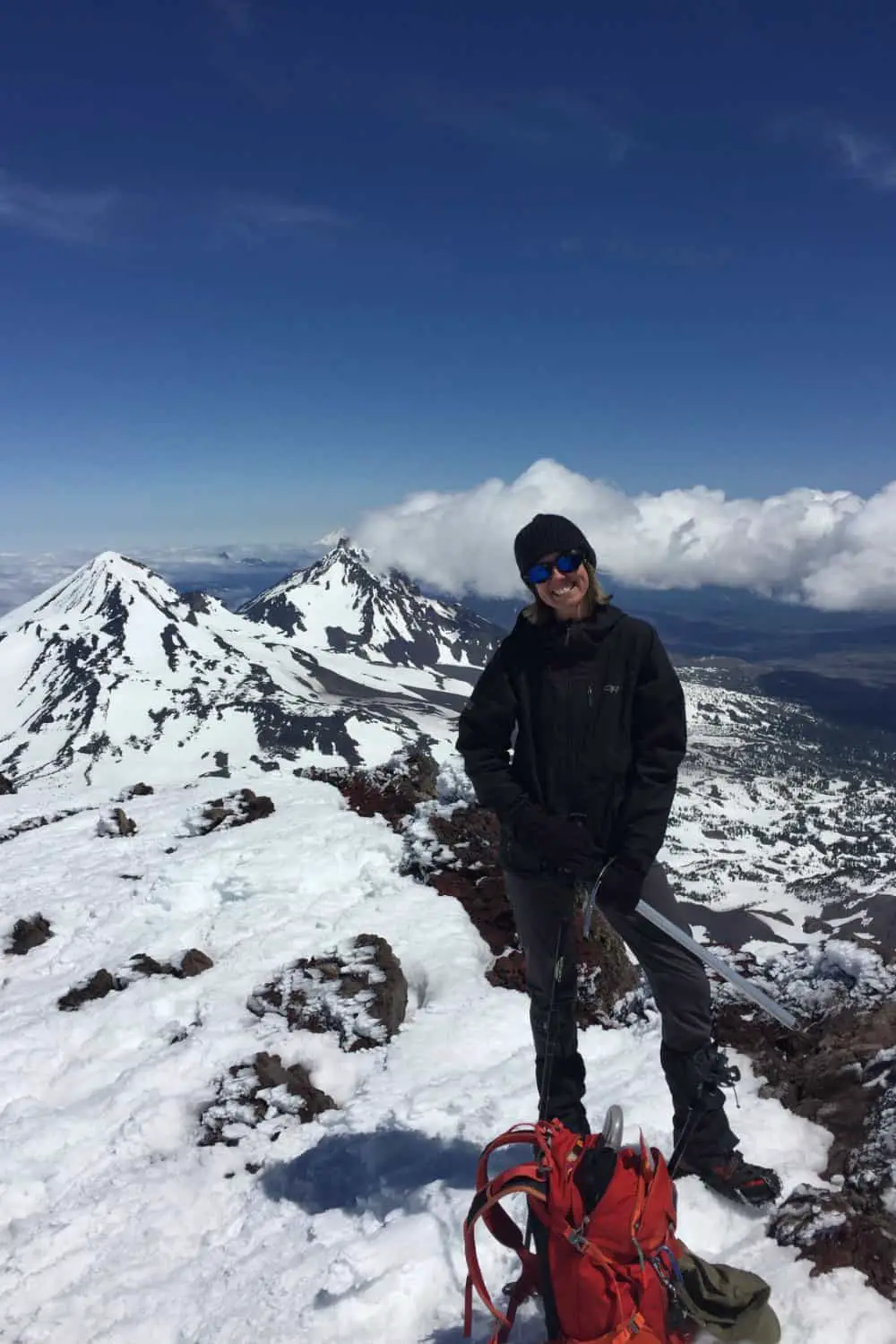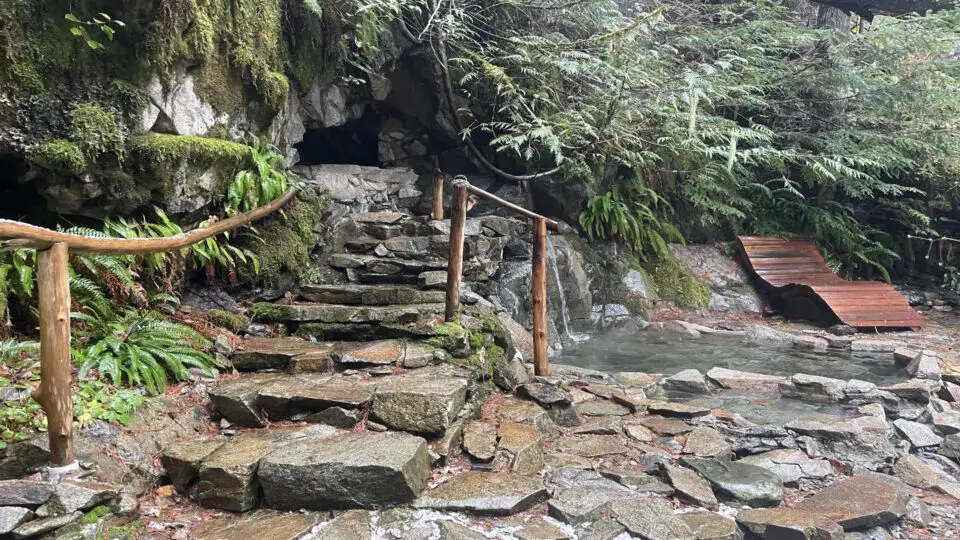I find it impossible to talk about this magical little enclave and not use the words “hidden gem.” Located just 50 miles from Seattle but light years away from city life, Goldmyer Hot Springs is one of western Washington’s best kept secrets, likely due to a strict reservation system and a very rough road and long walk to the trailhead. Stepping onto the property is like stepping into a little Hobbit land of old growth trees, handmade signs, hand railings made from branches sanded and worn smooth, a cave, and a series of cascading pools not far from a roaring-but-not-too-loud river.
The reservations process is a highly competitive lottery with hundreds of people applying for a mere 20 spots per day broken into two sessions. While this can be frustrating for those not getting in, it preserves the land and the feeling of solitude and wilderness that people are seeking when they take to the mountains for rest and rejuvenation.
Things to know before you go:
A Little History Of The Property
With a rich history going generations back with native Snoqualmie tribes, the springs were developed first in the early 1900s by William Goldmyer as a lodge for local miners and loggers. He mined the springs for hot mineral water until the 1920’s, then sold the property to Bill Morrow in the 1920s. Morrow had visions of a grand resort and built several small footbridges and outbuildings, but extensive flooding of the valley in January of 1960 took out most manmade structures and the property was all but abandoned. Then a 1966 article in the Seattle Times inspired crowds of naked hippies to make the springs the new party spot, and by the early 70s unrestrained public access resulted in vandalism and destruction by thousands of careless visitors and culminated in the original lodge being burned to the ground by squatters in 1972. In 1976, Bill’s sister Velda Morrow took the reigns and the resort reemerged with an eye toward restoration, conservation, and preservation.
Velma, John, and Josephine Morrow founded the nonprofit NWWP (Northwest Wilderness Programs) in 1976 as a response to the abuse the property suffered and with a mission to “provide wilderness experiences to the public while maintaining the long term preservation policies for the hot springs property and surrounding eco-system.”
To this day, the NWWP owns and operates Goldmyer Hot Springs, and a group of volunteers manages reservations and runs the property, which is once again a beautiful, clean, safe, serene place for people to soak in the magic of the lush old-growth forest that envelops that whole Middle Fork Snoqualmie river valley area.
The Forest Primeval
If anyone remembers the first few lines of Evangeline, A Tale Of Acadie:
“This is the forest primeval. The murmuring pines and the hemlocks, bearded with moss and in garments green, indistinct in the twilight, stand like Druids of eld, with voices sad and prophetic, Stand like harpers hoar, with beards that rest on their bosoms. Loud from its rocky caverns, the deep-voiced neighboring ocean speaks, and in accents disconsolate answers the wail of the forest.”
Henry Wadsworth Longfellow, 1807-1882
The Middle Fork Snoqualmie valley is considered a temperate rainforest; Goldmyer Hot Springs exists in one of the last remaining intact ancient forest ecosystems in North America, getting twice as much rain as Seattle and hosting many rare plants that are only found in ancient forest ecosystems. To say the area is green, or lush, or mossy is an understatement. It is, as the kids say, a vibe. A cozy Tolkeiny vibe that makes you think of gnomes and mushrooms and faeries and little wood nymphs.
Three Hots And A Cold
Hot springs are created from geothermal heat (heat from the earth’s interior). If water percolates deep enough into the crust, it comes into contact with hot rocks and can then recirculate to the earth’s surface forming hot springs. Geysers are the largest and most well known geothermal feature, hot springs are smaller and tamer but in the same family.
HOT: The temperature of the water at the source of Goldmyer Hot Springs is 125ºF. The highest and hottest spring is in a cave going back 30 feet into the rocky hillside, its waist deep water almost too hot to take, its steam giving it a shroud of mystery, its light sulfur aroma evoking volcano thoughts (the smell is there but not that sickening rotten egg smell that some sulfur vents emit). In the cave itself, the air temperature remains around 111ºF and the water is consistently right around 104º. Though shallow, it’s very relaxing to swim gently back and forth, feeling the tension leave your body as you float and turn lazily, closing your eyes, tapping into something primal.
WARM: The crystal clear water flows via miniature waterfalls down into each of the subsequent three pools and gets progressively cooler until it feels more like a warm but not piping hot bath, maybe just 100º or so degrees.
COLD: There’s a refreshing cold water pool right next to the hot springs for those folks who like to wake up their circulatory system with a little back and forth from hot to cold.
With a moderately high pH of 8.5, Goldmyer spring water contains traces of the following minerals: sodium, chloride, silica, bicarbonate, sulfate, potassium, and calcium.
Health Benefits Of Hot Springs
Hot springs have long been touted for their health benefits, such as:
- Boosting blood circulation
- Soothing skin problems
- Bringing relief to joint pain
- Relaxing the mind
- Relaxing the muscles
- Helping with digestion
- Easing menopause symptoms
Whether hot springs can make any sort of actual medical claims is debated, but most folks can’t argue with the feelings of deep peace and relaxation — the benefits of which are felt both while soaking and for days afterwards.
Reservations
Speaking of relaxation, the reservation system keeps the crowds at bay and allows guests to feel some semblance of solitude-ish. By limiting the number of visitors each day to 20 (divided into an AM and a PM session) including overnight campers, guests can enjoy a more intimate and less crowded experience. Putting a cap on the number of visitors also supports the NWWP’s restoration efforts and commitment to limit the amount of human impact on the environment.
Please see Goldmyer’s website for reservation details. It’s a very specific process and you need to follow their instructions to a T. It’s a lottery system; a calendar is released on the first of each month and people can put in three choices. Hundreds of people apply for each day but midweek sees slightly less action, so if your schedule allows, applying for weekdays could up your odds.
Walk-ups are not permitted at this time so please do not make the trek out there hoping to snag a cancellation’s spot– with 3-4 hours total travel time from the Seattle area it would suck to get there and get turned around.
Prices
Prices for the Goldmyer Hot Springs are as follows:
- Children: Free
- Adults (18-64): $20
- Seniors: $15
- Camping: add $5 per night per person 18 years of age and older.
Miscellaneous Information:
The hot spring pools are throughly cleaned twice a week. During this time, the pools are closed, drained, scrubbed, and refilled. Cleaning takes around 5 hours and is done by the caretakers.
Goldmyer is a clothing optional spring. If you’re looking for a less revealing time, please speak to the staff when you make your reservation.
Currently, Goldmyer is following typical covid protocol, with guests needing to show proof of vaccination and wear a mask if inside the office.
It’s ok to bring food as long as it stays at the cabana or the picnic area, not in the pools. Plastic buckets are provided to protect your snacks from critters.
Getting There
Talk about Mr. Toad’s Wild Ride. Best save this drive for your high clearance vehicle as about six miles of the road is very rough: with 8-10 inch deep potholes and made of more rocks than dirt, the road features multiple dips where it crosses dry riverbeds and little gullies and is notorious for bring blocked by downed trees or large branches.
If you’re lucky enough to score a reservation, Goldmyer staff will send you specific directions. But just so you have an idea of where it is, think an hour plus east of Mailbox Peak: you’ll do about 12 miles on Road 56/Middle Fork Road, then 6 miles on the lumpy-bumpy forest road that gets to the gate, where you begin the 4.5 mile road walk “hike” to the office where you then check in, fill out waivers, and get the lowdown from the caretaker as well as directions up to the springs.

Wendy Harrington is a California native who has lived in a small town at the foothills of the Cascade Mountains in Washington state since 2001. Her love of trail running and peakbagging has led her to summit all five Washington volcanoes, climb to the high points of three states, and put nearly a thousand miles a year on her boots. Her loves include ridgelines, saddles, granite, one-day pushes on big mountains, anything volcanic, long solo days, and objectives that push limits and test endurance.

